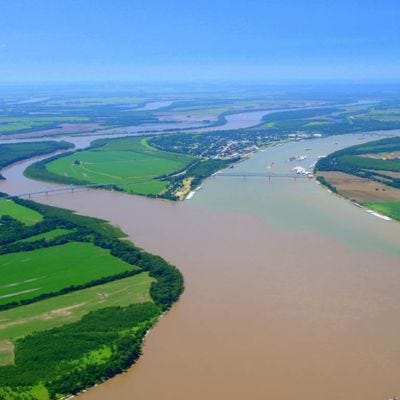
On this Sunday, the Ohio River was above flood stage where it enters the Mississippi River at Cairo, Illinois.
The flood stage at Cairo was 40 feet. The Ohio River measured 40.8 feet.
The Ohio River is the larger of the two rivers at the confluence. But here, where the waters double in width to form “The Mighty Mississippi,” the Ohio disappears in name. Also known as “Old Man River,” the Mississippi River “keeps on rolling” another thousand miles until it empties into the Gulf of Mexico.
Forty-six miles up the river, the Ohio also reached the flood stage of 39 feet at Paducah, Kentucky.
Bennett Swenson of the River and Floods Division of the Weather Bureau would later report:
[T]he lower Ohio River was receiving considerable quantities of water from its three largest tributaries at the very beginning of January and it continued to rise at a steady rate.
The three main tributaries of the Ohio River are the Tennessee River, Wabash River and Cumberland River. The Tennessee, the largest of the three, is equal in water volume to the Ohio River.
Swenson would continue:
As early as January 8 portions of the lower Ohio River were above flood stage and on the 10th the river was above flood stage from the mouth at Cairo, Ill., to Paducah, Ky., [and] nearly up to flood stage from there to Louisville, Ky.
In fact, the entire Ohio River was filling with water.
From its headwaters in Pittsburgh, Pennsylvania, to Louisville, Kentucky, the Ohio was one-half to two-thirds full. Farther southwest, in the area around Evansville, Indiana, the river was almost full. At Paducah, Kentucky, the river was full, according to a reading by the U.S. Geological Survey.
If this was a cause for concern, it was not evident in the newspapers. Reaching flood stage along portions of the Ohio River was a normal occurrence, although less so during the winter months.
Newspapers, diaries and other sources would not sound the alarm about high waters for another week or so.
Charles Field of Jeffersonville, Indiana, would soon write:
The river, since it had been raining more or less almost every day since Jan. 1st, had been filling up below [Jeffersonville] and had reached flood stage or better all the way from the mouth of the Ohio to above Cincinnati. All rivers flowing into the Ohio below Jeffersonville were extremely high.
The rainy weather that began in the Ohio and Mississippi valleys after New Year’s was about to intensify.
Start at the beginning of The 1937 Flood Journal or access the archives.
FRIED BOLOGNA: Family Stories from the American Midwest and Upland South Join me for stories about my ancestors who lived, worked and traveled in the hills and along the rivers of Arkansas, Illinois, Indiana, Iowa, Missouri and beyond.




